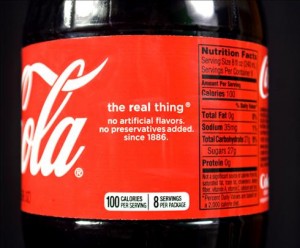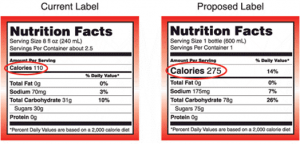Coca-Cola reveals calories?
Well, sort of reveals. Coca-Cola announces that it will put calories on the front of its packages (so you don’t have to search for and put on glasses to read the Nutrition Facts). You can see what the label will look like in the story in USA Today.
This sounds good but I view this action as another end run around FDA’s proposed regulations. In March 2004, the FDA proposed to require the full number of calories to be placed on the front of food packages likely to be consumed by one person, like a 20-ounce soda for example (see figure). A 20-ounce soda is 275 calories, not 100.
If Coca-Cola followed that FDA proposal, a label of a 2-liter bottle would have to say 800 Calories right on the front of the package.
This idea got stuck in Bush administration but there’s a good chance the new folks at FDA might take it up again.
Is Coca-Cola serious about helping people avoid obesity? If so, maybe it could send out a press release distancing itself from those consumer-unfriendly ads run by the Center for Consumer Freedom (see previous post).
Here’s another question: Does Coca-Cola fund the CCF directly or indirectly through the American Beverage Assocation or some other industry trade group? I will believe that they might really have an interest in consumer health when I know they have no connection whatsoever to CCF and its current ad campaigns.



